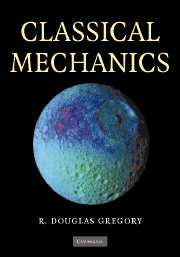Book contents
- Frontmatter
- Contents
- Preface
- 1 Newtonian mechanics of a single particle
- 1 The algebra and calculus of vectors
- 2 Velocity, acceleration and scalar angular velocity
- 3 Newton's laws of motion and the law of gravitation
- 4 Problems in particle dynamics
- 5 Linear oscillations
- 6 Energy conservation
- 7 Orbits in a central field
- 8 Non-linear oscillations and phase space
- 2 Multi-particle systems
- 3 Analytical mechanics
- 4 Further topics
- Appendix Centres of mass and moments of inertia
- Answers to the problems
- Bibliography
- Index
1 - The algebra and calculus of vectors
Published online by Cambridge University Press: 05 September 2012
- Frontmatter
- Contents
- Preface
- 1 Newtonian mechanics of a single particle
- 1 The algebra and calculus of vectors
- 2 Velocity, acceleration and scalar angular velocity
- 3 Newton's laws of motion and the law of gravitation
- 4 Problems in particle dynamics
- 5 Linear oscillations
- 6 Energy conservation
- 7 Orbits in a central field
- 8 Non-linear oscillations and phase space
- 2 Multi-particle systems
- 3 Analytical mechanics
- 4 Further topics
- Appendix Centres of mass and moments of inertia
- Answers to the problems
- Bibliography
- Index
Summary
KEY FEATURES
The key features of this chapter are the rules of vector algebra and differentiation of vector functions of a scalar variable.
This chapter begins with a review of the rules and applications of vector algebra. Almost every student taking a mechanics course will already have attended a course on vector algebra, and so, instead of covering the subject in full detail, we present, for easy reference, a summary of vector operations and their important properties, together with a selection of worked examples.
The chapter closes with an account of the differentiation of vector functions of a scalar variable. Unlike the vector algebra sections, this is treated in full detail. Applications include the tangent vector and normal vector to a curve. These will be needed in the next chapter in order to interpret the velocity and acceleration vectors.
VECTORS AND VECTOR QUANTITIES
Most physical quantities can be classified as being scalar quantities or vector quantities. The temperature in a room is an example of a scalar quantity. It is so called because its value is a scalar, which, in the present context, means a real number. Other examples of scalar quantities are the volume of a can, the density of iron, and the pressure of air in a tyre. Vector quantities are defined as follows:
Definition 1.1 Vector quantityIf a quantity Q has a magnitude and a direction associated with it, then Q is said to be a vector quantity.
- Type
- Chapter
- Information
- Classical Mechanics , pp. 3 - 24Publisher: Cambridge University PressPrint publication year: 2006



